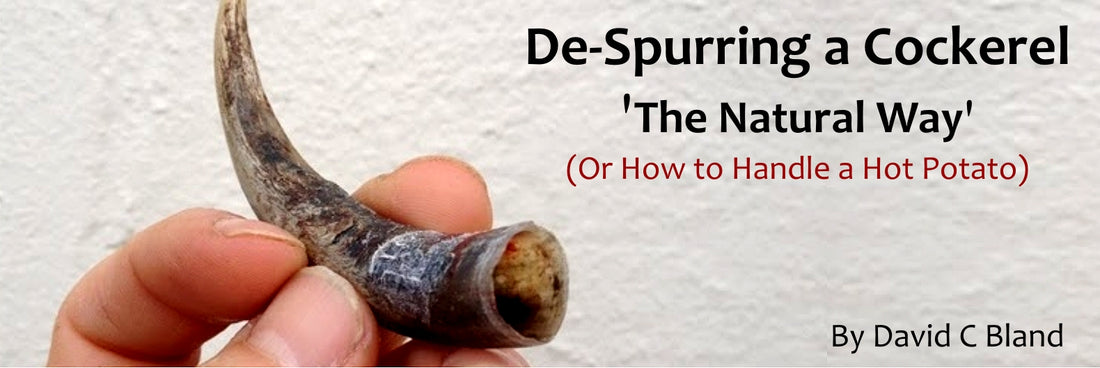For many years, the virtues of relieving a cockerel of overgrown or deformed spurs with the use of a hot potato have been extolled.
Those who have frequently reminded me of this method have unfortunately never actually carried out the operation themselves. The result is that no actual details have been forthcoming from any of my sources.
I was once asked to trim a cockerel's spur - one of which had become so distorted the cockerel had real difficulty in settling down for the night without enduring a very sharp point in the region of it's rear orifice!
With the help of photographs, I will help all interested parties through a very simple and seemingly painless operation.

The first picture is before the work has been started. The second picture shows one leg bandaged. This is to protect the cockerel's leg from any uncomfortable heat whilst the potato is held firmly against the leg. The potato, having been baked in the microwave, is then cut in half ready for use.
The second half of the potato is kept warm awaiting its turn. With the use of a glove on one hand, hold the potato firmly down on the cockerel's spur, the spur being totally encased. It is held in this position for approximately five minutes. I had been told that the cockerel's spur would become soft and pull off, leaving a soft squidgy centre, which would dry by the morning. In actual fact, I took the potato off after five minutes and the spur was still firm and apparently still securely attached. It was only after several seconds cooling that with a firm push, rather than a twist, the spur parted from the cockerel's leg, and as you will see, left a perfectly formed new spur in its place.

The above pictures show both new spurs intact, and the hollow outers once off. At no time whatsoever did the cockerel attempt to escape, nor were there any twinges denoting some kind of feeling during the whole process. Afterwards, the cockerel was placed in a small run with feed and water (which he immediately got stuck in to). The red colour on the horn isn't blood, nor were the new spurs at all sensitive. The cockerel's only problem was to re-adjust himself back to a normal proud walk, as he had to make adjustments before the treatment, as the spurs had gradually become overgrown.
Within a couple of days, the cockerel was back to his old virile condition, and the hens accepted him, without the fear of having their backs torn,neither did he keep losing his balance, as and when the previous overgrown spurs tangled him during such a delicate operation. I shall definitely be using this system again. It is far better than cauterising a cockerel with a de-beaker, or trying to cut chunks off with a pair of hoof trimmers or pliers (I have heard of others trying out). In fact the cauterising method does cause some pain to the cockerel but at the time, (until now) seemed to be the only alternative.
--------------------------------------------------------

David C Bland
SPR Centre's founder David C Bland published his first book 'Poultry for the Garden' in 1975. This very successful book has now been reprinted for the third time and is probably the only book which has stood the test of time, being as popular today as when it was first published. Further successful books written by David since then include 'Practical Poultry Keeping' in 1996, and 'Turkeys, a Guide to Management' in 2000. David has also written columns for Smallholder Magazine, Fancy Fowl Magazine, and Feathered World Magazine.
In 2007 David also became an Executive Committee Member and Director of UKEPRA - The United Kingdom Egg Producer Retailer.
Now in his eighties, David has retired from running the company. However, SPR Centre is still going from strength to strength under the very capable hands of his two sons Barrie and Dave, and his daughter Debbie.
--------------------------------------------------------

